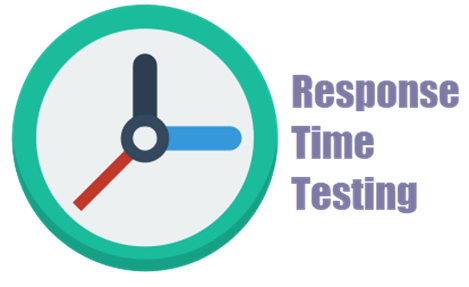Software Testing
Unit Test vs Integration Test: What's the Difference?
What is the Unit Test? Unit Tests are conducted by developers and test the unit of code( aka...
Response Time Testing measures the time taken for one system node to respond to the request of another. It is the time a system takes to reach a specific input until the process is over. For example, you have API, and you want to know exactly how much time it takes to execute it and return data in JSON. Response Time measures the server response of every single transaction or query.
Response time starts when a user sends a request and ends at the time that the application states that the request has completed.

Response Time Testing
In this tutorial, you will learn
To Measure Response Time, we can use test tools by surrounding an important business process with Start and End transactions. A business process may be an action or a set of actions which users perform in application to complete a business task like login to the application or to purchase a book on Amazon.com
For the same process to Measure response time for an API, the response will vary slightly from tool to tool. Here is why
| Response Time Metrics | Explanation |
|---|---|
| Average Response Time | The Average Response Time is the average time taken for every round trip request. The Average Response Time includes the loading time of HTML, CSS, XML, images, JavaScript files, etc. Therefore, the average is affected when slow components are present in the system. |
| Peak Response Time | The Peak Response Time helps us to find potentially problematic components. It helps us to find all the irregularity in the website or system where a certain request is not handled correctly. For example, there may be a large database query executed which can affect the response time. This query does not permit the page to load at the desired time. |
| Error Rate | The Error Rate is a mathematical calculation which displays the percentage of problem requests against all requests. This percentage counts all HTTP status codes displaying an error on the server. It also counts requests which are time out. |
Response Time Test has two most essential characteristic:
It shows how long a user needs to wait for the server to the response its request.
Following are key Response time testing example values
| Response Time | Significance |
|---|---|
| 0.1 Second | It is most preferred response time. If the response time is 0.1, users always feel that the application or system is responding instantly, and do not feel any interruption. |
| 1.0 Second | It is the defined as the maximum limit of acceptable response time. Users are unlikely to feel any interruption, though they may experience some delay. The response time of more than 1-second may interrupt user experience. |
| 10 Seconds | It is a maximum limit after which response time goes beyond the acceptable limit. However, in today's time, if response time exceeds 6 seconds, the user will leave that site or quit the application. |
Generally, response time should be fast as possible in the interval of 0.1 - 1 second. However, people can adapt a slower response times, but they will never be happy with a response time greater than 2 seconds. Lesser the response times, better is client satisfaction, lesser costs, higher customer satisfaction.
There are many Response Time testing tools are available in the market. Three most prominent Examples of response time testing tools are:
1) JMeter:
Jmeter can be used for Load and Performance Testing on the target application.
Download link: http://jmeter.apache.org/download_jmeter.cgi
2) Load Runner:
Load Runner is a load testing product developed by Microfocus. LoadRunner response testing tool works on the principle of simulating Virtual Users on the subject application.
Download link: https://software.microfocus.com/de-de/products/loadrunner-load-testing/free-trial
3) AEM:
Adobe Experience manage which is shortly known as AEM is another effective tool for testing response time. It allows checking problematic queries, request and error message.
Download link: https://helpx.adobe.com/in/experience-manager/6-3/sites/developing/using/aem-eclipse.html
What is the Unit Test? Unit Tests are conducted by developers and test the unit of code( aka...
What is Test Documentation? Test documentation is documentation of artifacts created before or...
What is System Integration Testing? System Integration Testing is defined as a type of software...
To take the ISTQB Advanced Level exam, you require a Foundation Level Certificate. ISTQB also...
What is Domain Testing? Domain Testing is a Software Testing process in which the application is...
In this tutorial, you will learn- What is Design Validation? What is Design Verification?...